What Is The Best Animal In The Safari Desert
Read our take on the 15 most iconic and intriguing desert animals to encounter in Africa whilst on a desert safari.
Africa is made upwardly of many habitats, with over one-third of the continent covered by nine deserts. Two of these African deserts make it onto our listing of the ten largest deserts in the world. Whilst there is seemingly plenty of nothing in African deserts, they offer a unique environmental and cultural history dating back millions of years, and, in places, are home to excellent wildlife viewing opportunities.
Whilst the lack of water in deserts is an impediment to an abundance of wild fauna, there are a number of found and animate being species that have adapted to a desert environment and call the desert home. When people think of a desert, it's often camels and snakes that come to mind, however, foxes, antelopes, elephants, and lions are mutual desert species, all worthy of any safari animate being sighting.
What is a desert?
Deserts are divers as dry regions receiving less than 12 inches of atmospheric precipitation annually, and are formed when regional climate changes result in long-lasting drought conditions.
In Africa, the deserts are besides characterised by warm to very hot daytime temperatures with libation nights.
There are many ways desert animals have adjusted to the lack of water and extreme temperatures that their habitat brings. These include:
- Existence nocturnal, only coming out at dark when information technology'south absurd.
- Burrowing nether the ground or sand to observe less extreme and more consistent temperatures.
- Existence able to get days without drinking, or fifty-fifty obtaining all of their water from their prey.
- Extended trunk parts – commonly ears, but also legs and other body parts – to aid dissipation of heat
The deserts in Africa are home to some of the most extreme landscapes and stark weather on earth, and offer an incredible backdrop for the variety of desert animals they are abode to. With this in listen, below nosotros list xv of the most iconic desert animals to spot in Africa:
Angolan giraffe
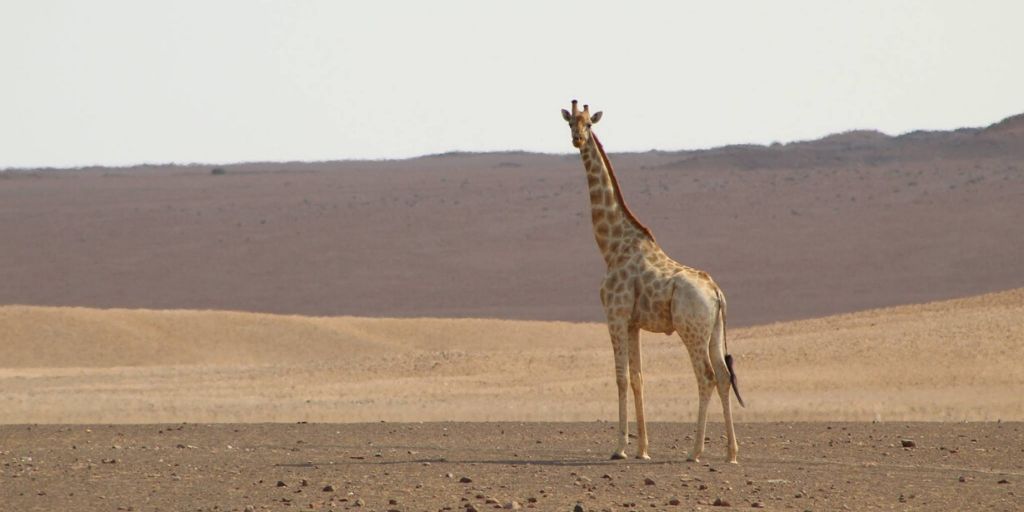
An angolan, desert giraffe, continuing in dunes
Perhaps the ultimate iconic African savanna animal, the giraffe is also found in some of Africa'due south deserts. The unmistakable land mammal is recognizable for its long neck and spotted glaze, and known by Arab prophets as the 'queen of the beasts' because of their delicate features and graceful poise.
With nine subspecies sharing its distinctive characteristics, this safari animal is the tallest in the globe by some way. The giraffe'due south glaze is characterized by dark blotches on lighter hair. With age, male giraffes may go darker, and while calves inherit spot patterns from their mothers, each giraffe has a unique glaze pattern that sets it apart. It has a abrupt sense of hearing and olfactory property, some other defense confronting predators, while it tin close its nostrils during sandstorms and confronting ants.
Black footed cat

Blackness-footed cat by a burrow
The black-footed cat is the smallest wild cat in Africa and 1 of the smallest wildcats in the earth, weighing 2 kg and continuing 0.25 meters tall. They're nocturnal animals, and rarely seen, found simply on the grassy plains and desert areas of South Africa and Namibia. It's estimated that these cats can kill and eat up to 3,000 rodents a yr, and a desert adaptation means they can obtain all the moisture they need from their food.
Black rhino

Black rhino walking in desert
Rhinos are something you lot just need to see to sympathize how impressive they really are. A rhino sighting is always special and as yous look in awe your heart volition definitely skip a shell.
Once widespread through sub-Saharan Africa, the rhino has been hunted to the brink of extinction and is probably the hardest of the big five to spot in the wild. There are ii species of rhinoceros in Africa – the blackness rhinoceros (Diceros bicornis) and the white rhino (Ceratotherium simum).
Whilst white rhinos have made a comeback through conservation efforts beyond the continent, black rhinos are still very much one of Africa's endangered animals, and one of the hardest safari animal to spot. The primal differences between the white and blackness rhino are not color, but rather size, temperament, food preference, and mouth shape.
Desert cheetah
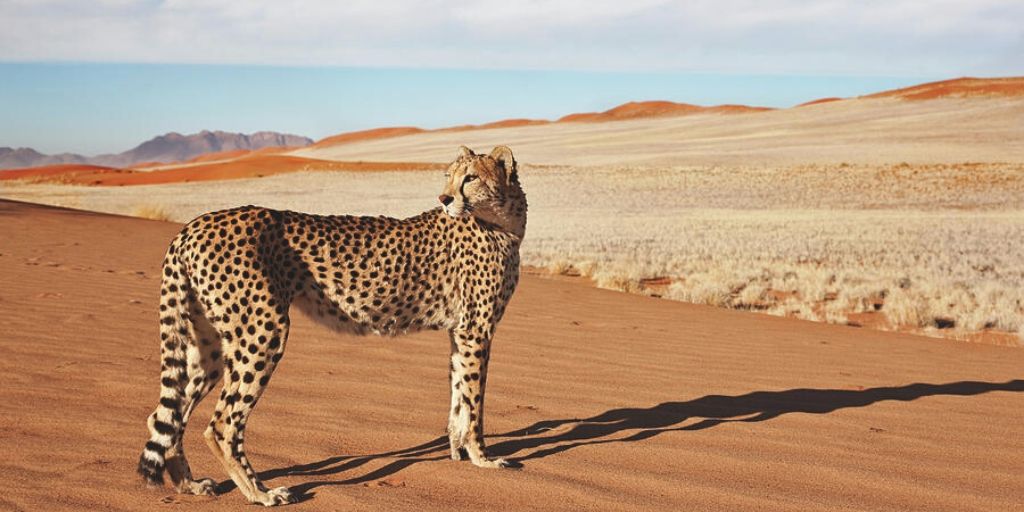
Desert chetah standing in Namib Desert
The cheetah is famous for existence the world'southward fastest animal on land. This mammal tin can do 120 kilometers per hour and can accelerate from 0 to 95 kilometers in merely 3 seconds. These cats need land and infinite, and seeing 1 in activeness is an incredible sight. But there is more to this true cat than just speed; information technology is cute and svelte, and sadly, it's endangered.
For an animal that hunts during the mean solar day, good eyesight, stealth, a spotted glaze, and top-notch speed are crucial for survival. The tear marks are among the summit distinctive features used to tell the cheetah and the leopard apart
Desert elephant
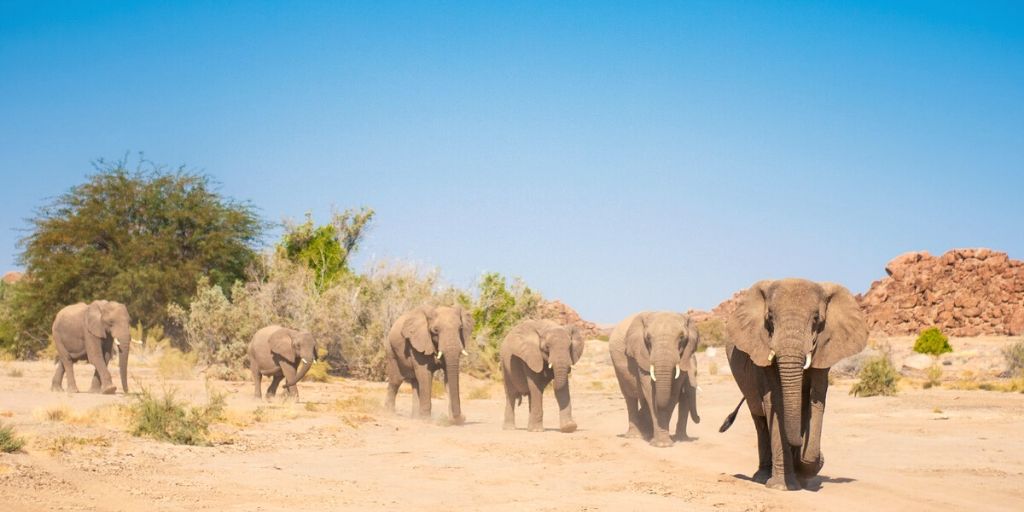
A desert elephant family
(Loxodonta africana) is the largest and heaviest state brute in the world, weighing up to 6 tonnes. You will be stunned past the sheer size and presence of these creatures, not only on the commencement fourth dimension you see them merely every futurity.
Elephants play a vital role in the survival of other species past earthworks waterholes in dry riverbeds, spread seeds through theirs faecal matter and their trails human action every bit fire breaks on the mural, and they exercise all this on only 2 hours slumber in a 24 hr period!
Desert leopard
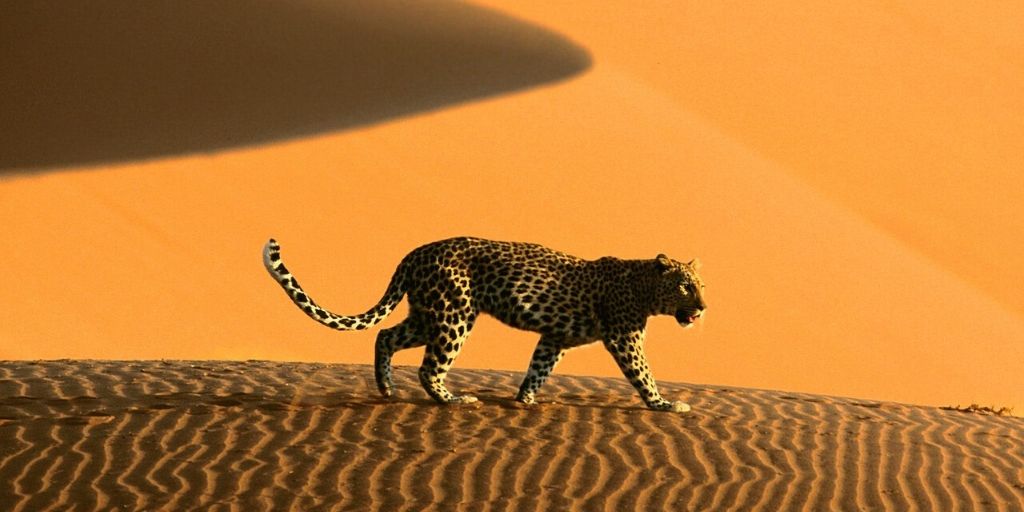
Desert leopard stalking in dunes
The elusive leopards are one of the shyest and least sociable animals in the fauna kingdom, but are however opportunistic hunters and are highly adaptable. Watching a leopard carry its casualty upward a tree is a fantastic sight and one of the best opportunities you lot could hope for.
Slightly smaller than their lion cousins, leopards (Panthera pardus) are less rare than you might call up, but rely on camouflage and existence active at nighttime to stay hidden.
Leopards are solitary, independent creatures, and rarely seen together except during mating, or a mother with cubs. As such they are totally self-reliant, and expert hunters – sometimes killing prey up to twice their size. During the daytime they often lounge around in copse and come to the ground afterwards dark to hunt, taking their prey up into a tree to eat at their leisure.
Desert lion

Desert king of beasts walking in the Kalahari sand
Flying in at first identify is the lion, also known as the king of the jungle. Lions are the largest and near sociable of Africa'southward cats. At upwardly to 225kg, the lion (Panthera leo) really is the king of the savanna (not jungle!), but are likewise desert-adapted animals in places similar the Namibi Desert.
When y'all hear them roaring during the night, or the day, you'll be amazed at how loud and powerful they actually are – don't worry well-nigh not hearing the lions snarls or roars as they can exist heard from up to 8 kilometers abroad. It actually is a once in a lifetime opportunity to run across lions hunting, or panthera leo cubs playing with each other.
Dromedary camel
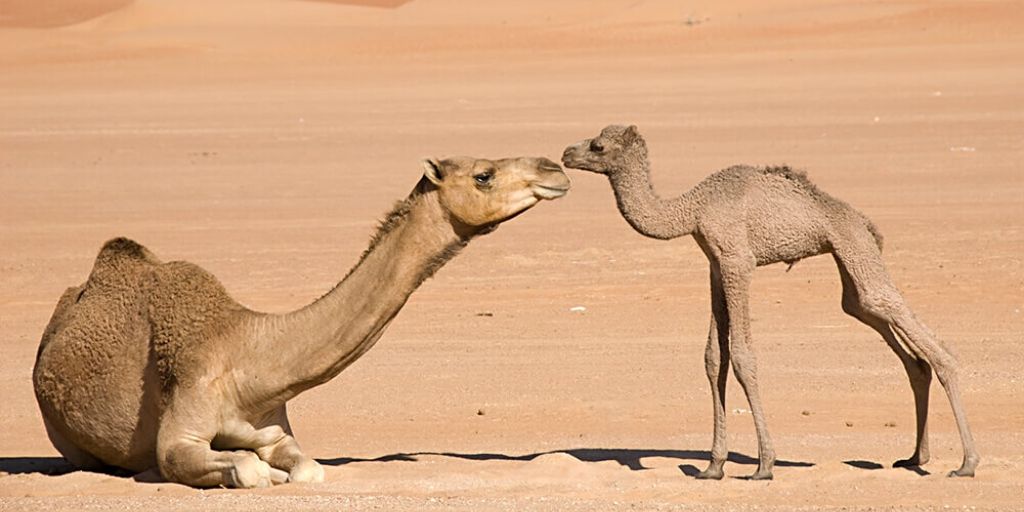
The ultimate desert animals – female parent and camel foal
The ultimate desert animals, dromedary camels are well adapted to their weather condition, with closable nostrils close to go on sand at bay, and bushy eyebrows and two rows of long eyelashes to protect their eyes. They take large anxiety to spread their weight across the sand for support, and a large hump on their dorsum to shop fatty. They drink large amounts of water – up to 90 literes at a time – which they shop in their bloodstream.
Fox – Bat-eared and Greatcoat
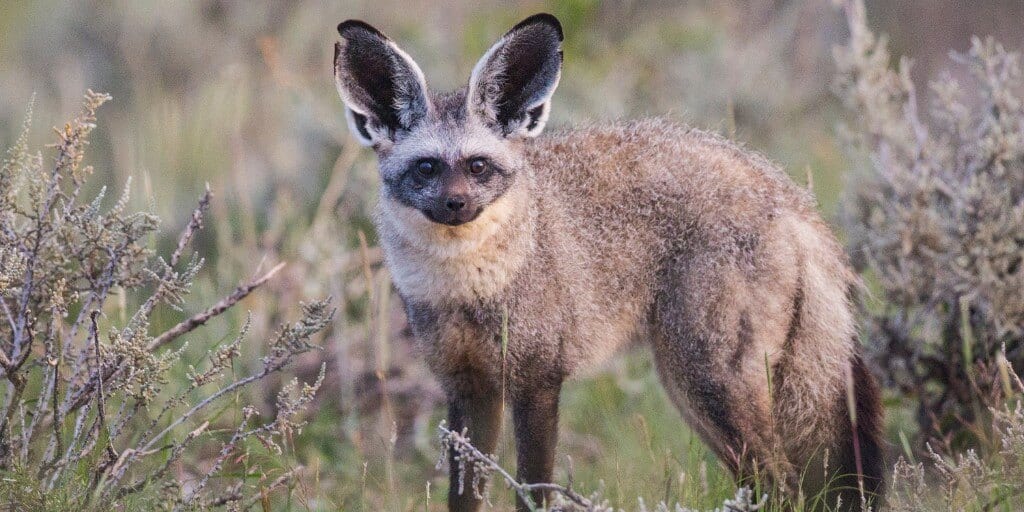
Bat eared pull a fast one on in scrub
As the name indicates, this fox has unusually enormous ears in proportion to its head, like those of many bats. Their bodies are generally yellow-dark-brown with a pale throat and underparts. Bat-eared foxes are primarily plant in E and Southern Africa where there are curt-grass plains and plenty of termites and beetles.
Read more than about the bat-eared fox.
Hartmann's zebra
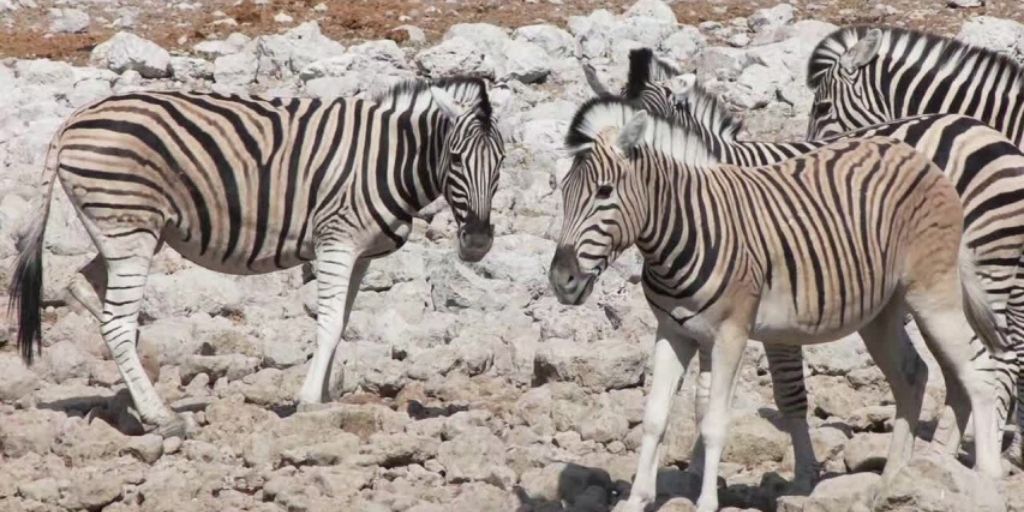
Hartmann'southward zebra in Etosha's white rocky desert
Zebras are perhaps the almost fashionable of Africa's stars, with their characteristically stunning coats of black and white stripes. These distant relatives of the equus caballus are a frequent sight on any African safari and consist of three different species.
There are many theories almost why zebras evolved stripes, and it seems that perhaps the virtually likely answer is that the stripes function as a way to deter biting insects like tsetse flies and mosquitos.
Hyena – Brown and Spotted
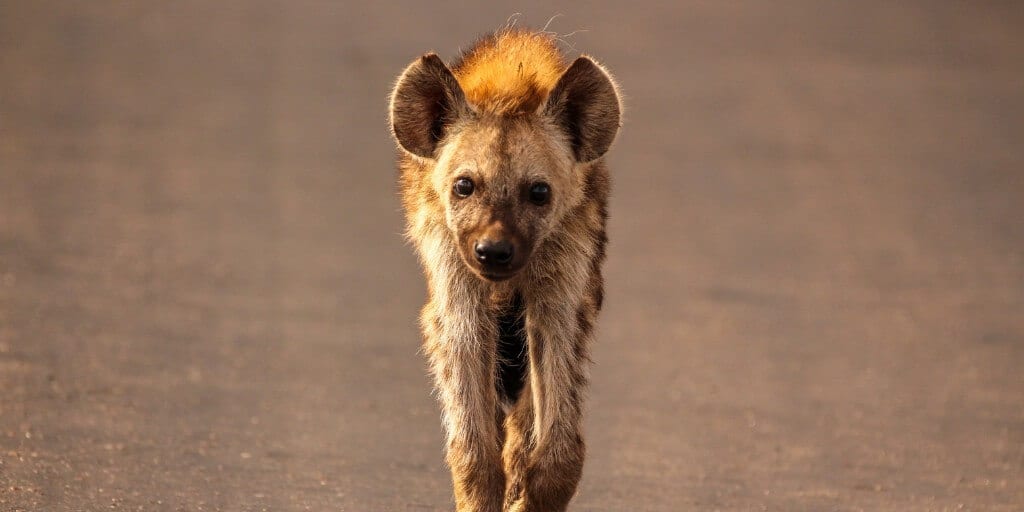
A hyena cub close up
There are 4 species in the hyena family, varying in size. Hyenas are unique and vital components of most African ecosystems, both taking reward of other animals' kills for like shooting fish in a barrel meals and hunting themselves. The size of a hyena impale or scavenge is more often than not determined by the size of the hyena's clan, which tin run to dozens. They often hide extra food in watering holes, since nothing is wasted. Hyenas will eat every part of an animal, including bones and hooves.
Lapet faced vulture
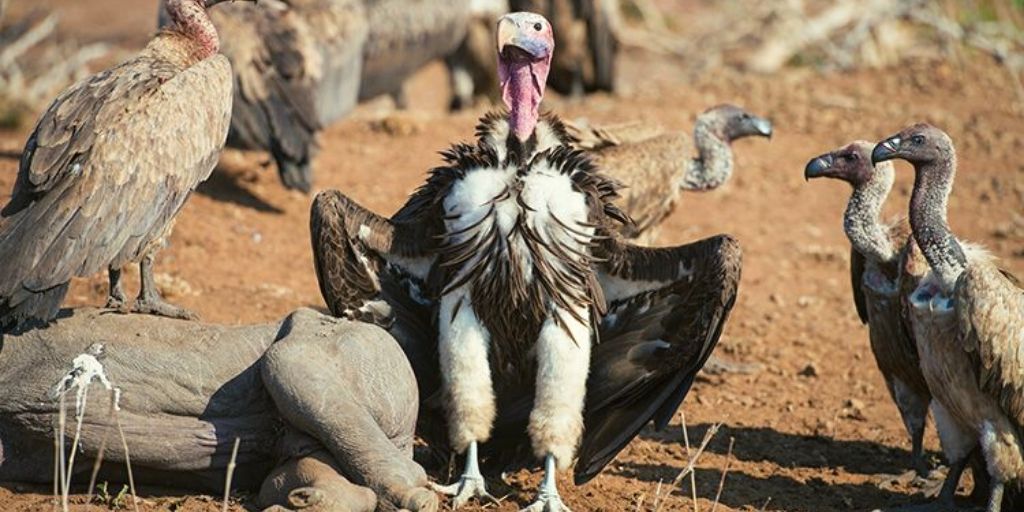
Group of lappet-faced vultures
The Lappet-faced Vulture has the largest wing-span of all the birds of Africa, and besides goes by the names Nubian vulture and African eared vulture. The species is hands recognizable due to its large size, bare pink head, and the lappets on each side of its neck – the fleshy folds of skin.
Meerkat

Three meerkats standing in the dominicus
The meerkat, or suricate, is a small carnivoran in the mongoose family unit. It is the but member of the genus Suricata. Meerkats live in all parts of the Kalahari Desert in Botswana, in much of the Namib Desert in Namibia and southwestern Angola, and in South Africa.
Oryx
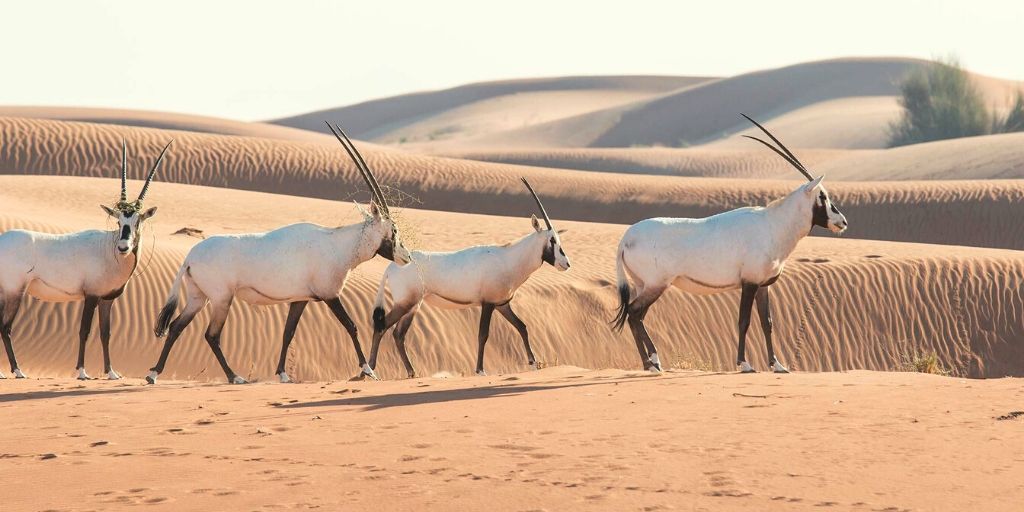
In that location are 4 species of oryx, all of which live in or on the fringes of desert areas, and tin can alive for days without drinking water. Oryx eat leaf, grass, herbs, shrubs, plants, legumes, juicy fruits and roots, and buds, generating the h2o they demand from these plant resources they eat.
Interesting oryx fact – the Arabian oryx is the showtime species to have changed back from 'Extinct in the Wild' to 'Vulnerable', equally categorized in the IUCN Ruddy Listing in 2011.
Ostrich

Two ostriches walking in the Kalahari Desert
The common ostrich is the tallest and heaviest bird in the earth, with an average height of over 2 meters (sometimes as tall as 2.7 meters) and a weight of upwards to 160 kg. At this size, the ostrich is, of form, flightless, but can outrun plenty of animals with its meridian speed of 69 km per hour. Their long, powerful legs double upwardly as defensive weapons which pack a powerful boot to would-be predators.
Ostrich are very well adapted desert animals, able to survive without water for days, generating water internally and extracting h2o from vegetation.
Sand cat
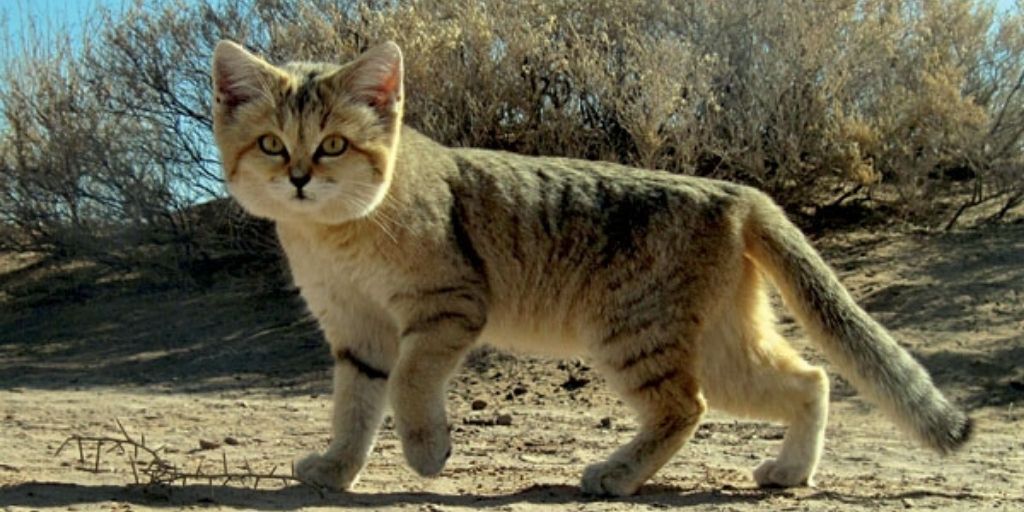
Sand true cat
The sand cat is the just wild cat in Africa – or the indeed world – that lives solely in desert environments, with a broad distribution beyond the Sahara, as well deserts in the Middle East and Central Asia.
Besides known as the dune cat and 'the true cat that digs holes', the thick, long hair on the soles of their anxiety is an adaptation to protect them against the desert extremes of hot and common cold temperatures. They are characterized past their flat, broad head and short legs, and stand up 0.35 meters tall, weighing in at three.v kg.
Have you lot had the opportunity to spot any of these desert animals in the wild? Permit us know about your desert animal experiences in the comments section below!
Source: https://safarisafricana.com/animals/desert-animals/
Posted by: catheysopupose.blogspot.com

0 Response to "What Is The Best Animal In The Safari Desert"
Post a Comment